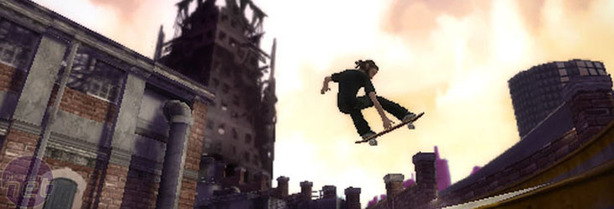
Skate it!
Publisher: Electronic ArtsPlatform: Wii and DS
Release Date: To Be Announced
It’s weird to be nostalgic for a console that isn’t yet out of date, but I remember the sheer feeling of potential that went through me when the Wii was first announced. It was strange, but wonderful.
Motion-sensing? Hell, that means first person shooters can be played with 1:1 movement – imagine how cool it would be to aim a gun with that?!
Naturally, the feeling gradually faded as the less-than-imagined weight of reality fell and crushed it to death. In use the Wii wasn’t quite as epic as we imagined, but that didn’t stop the same feeling rising up again when the Wii Balance board was announced later on.
Weight-sensing? Hell, that means that sports and snowboarding games can be played realistically, but safely!
Thankfully, this time it seems a bit more thought has gone into the Wii Balance Board and game developers are finally learning a bit more about how to make the best use of the technology available to them. In short, Electronic Arts’ Wii version of Skate 2 can actually make really good use of the Wii Balance Board.
“The Balance Board is really a very simple bit of hardware,” said the game's producer as we tried to get to grips with the game. “It’s essentially just four sensors that monitor pressure, so we had to think long and hard about how the game could use something that simple – assuming it was even possible. We have hundreds of different tricks, so it was a real challenge.”
Thankfully, it’s a challenge that EA was able to meet for the most part as using the Wii Balance Board feels like the natural way to play a game once you get used to it’s quirks. And while Skate It! may just be a graphically inferior port of the Xbox 360 and PlayStation 3 title to the cynics, the super-accessible control system is one place where Skate It! manages to ollie up over its prettier sibling.
For the most part, the Wii Balance Board handles similar to a real skateboard when you’re playing Skate It!. You stand atop the board, letting the game know what stance you’re in, and you shift your weight right and left to steer your board. You can slip into a manual whenever you want by tipping yourself fore or back and you jump up into an ollie by kicking your weight back suddenly – just like in real life.
That’s the basics of it all, but it’s also the most difficult thing to get used to unfortunately. Once you’re in the air things are easy, but getting there is harder than it sounds thanks to the natural instinct for you to properly jump in the air and try and do a totally realistic ollie. Over and again we found ourselves surrendering to the urge and each time the game would flash up a warning and a developer would collapse into a facepalm. Please don’t jump on the balance board.
“Unfortunately, the balance board just isn’t built for that type of punishment,” I was told. Punishment indeed? I don’t weigh that much!
The good news though is that once you’ve been reminded by the game for the eleventh time or so, it gets easier and you start to get into the flow of things a bit more.
It’s the same deal as it is with the rest of the Skate games – the controls take some getting used to and are geared more towards realism than in other skateboarding titles, but it’s worth the effort. Once you’re in the air, it’s simply a matter of knocking the board or shifting your weight around to his certain tricks – which the Wii manages to pick up with surprising ease.

MSI MPG Velox 100R Chassis Review
October 14 2021 | 15:04











Want to comment? Please log in.